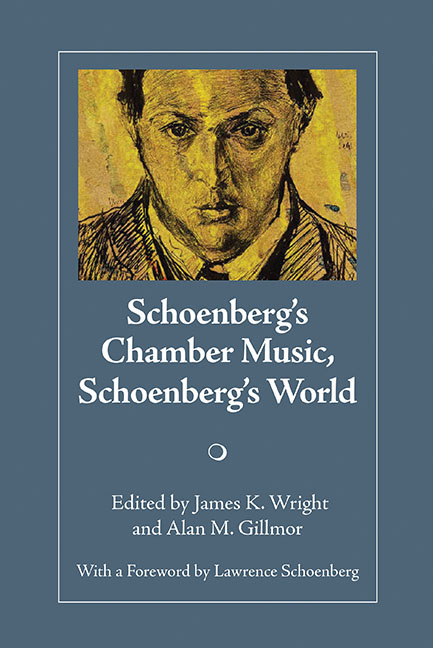Book contents
- Frontmatter
- Contents
- Foreword
- Preface
- HISTORICAL PERSPECTIVES
- The Young Arnold Schoenberg
- Schoenberg's String Quartet No. 1 in Dresden (1907): Programming the Unprogrammable, Performing the Unperformable
- A Bridge to a New Life: Waltzes in Schoenberg's Chamber Music
- The “Popular Effect” in Schoenberg's Serenade, Op. 24
- ANALYTICAL PERSPECTIVES
- OTTAWA SYMPOSIUM AND CHAMBER MUSIC FESTIVAL PHOTOS
- PERFORMANCE, RECEPTION, AND INTERNATIONAL INFLUENCE
The Young Arnold Schoenberg
from HISTORICAL PERSPECTIVES
- Frontmatter
- Contents
- Foreword
- Preface
- HISTORICAL PERSPECTIVES
- The Young Arnold Schoenberg
- Schoenberg's String Quartet No. 1 in Dresden (1907): Programming the Unprogrammable, Performing the Unperformable
- A Bridge to a New Life: Waltzes in Schoenberg's Chamber Music
- The “Popular Effect” in Schoenberg's Serenade, Op. 24
- ANALYTICAL PERSPECTIVES
- OTTAWA SYMPOSIUM AND CHAMBER MUSIC FESTIVAL PHOTOS
- PERFORMANCE, RECEPTION, AND INTERNATIONAL INFLUENCE
Summary
Schoenberg's early years are clearly worth exploring in order to understand the genesis of the composer's extraordinary art and thought. While ample resources and documentation are available for Schoenberg's work in the early twentieth century, little is known about the decade before 1900, the period during which he took the initial steps in his artistic development. Hoping to shed light on new evidence concerning Schoenberg's early years, our team at the Arnold Schoenberg Center mounted a special exhibition in 2007, titled “The Young Schoenberg,” which compiled and displayed original documents and manuscripts, as well as biographic and artistic sources archived at the Schoenberg Center and elsewhere. A scholarly symposium on the topic was also presented from 4-6 October 2007.
At the turn of the century, Vienna, the capital of the Austro-Hungarian Empire, was one of the largest metropolises in the world. As the center of the multi-ethnic state of Austria-Hungary, the city became home to a wide variety of nationalities, language groups, and religious confessions. At the same time it was home to avant-garde artists, renowned scientists, and rebellious intellectuals who comingled to give rise to a unique cultural ambiance. The work of thinkers and artists working in a wide variety of fields seemed to be interwoven in unprecedented ways.
Arnold Schoenberg was born on 13 September 1874, at Obere Donaustrasse 5 in Vienna's Second District, where he went to school and spent his childhood in modest circumstances. His Father, Samuel Schoenberg (1838-89) was an enthusiastic chorister and his mother, Pauline Nachod (1848-98), came from a family of cantors in Prague. Schoenberg began studying violin when he was eight, and a year later he made his first attempts at composing music: initially waltzes and pieces for violin, then polkas, marches, and his first songs.
“As a child of less than nine years,” he wrote, years later, “I had started composing little, and later large pieces for two violins, in imitation of such music as I used to play with my teacher or with a cousin of mine. When I could play violin duets of Viotti, Pleyel and others, I imitated their style.” Thanks to his cousin, the singer Hans Nachod (1883-1966), some of these early pieces, including several violin duets, have survived.
- Type
- Chapter
- Information
- Schoenberg's Chamber Music, Schoenberg's World , pp. 3 - 12Publisher: Boydell & BrewerPrint publication year: 2009



